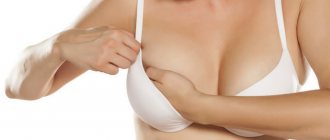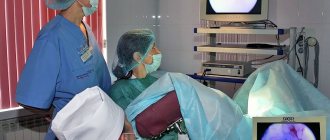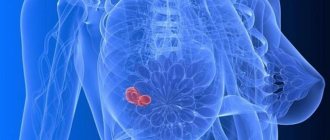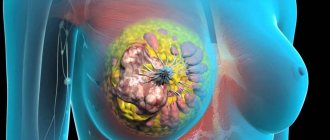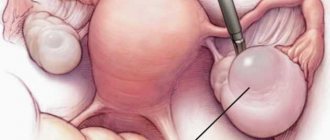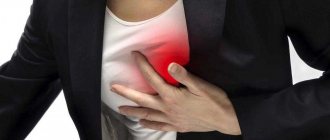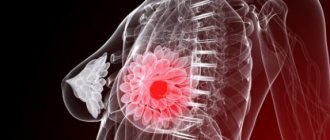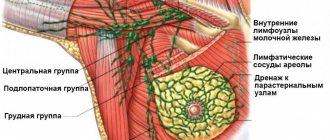Breast fibroadenoma is one of the most “harmless” breast diseases. According to the World Health Organization, up to 10% of the female population suffers from this pathology. In Russia alone, over 500 thousand new cases of the disease are registered annually. However, despite the “harmlessness”, operations for this disease are still performed frequently. How the condition of a woman with breast fibroadenoma changes after surgery and what complications may arise, the attending physician should talk about all this with his patient. But unfortunately, due to the workload of mammologists, they do not always have enough time for this.
Postoperative period
Removal of breast fibroadenoma
Removal of an adenoma is an invasive intervention, which is carried out using several techniques:
- sectoral resection;
- enucleation;
- laser removal, for which puncture is performed.
Compression underwear
The need to remove the formation, including mastopathy, is due to the fact that the disease may very rarely recur in the future. Each technique has its own level of trauma, which requires a certain amount of pain relief. Before the operation, the woman undergoes preparation, the doctor makes sure that there are no contraindications. Regardless of the chosen operation, further tissue restoration depends on the implementation of rehabilitation measures, which include:
- drug treatment;
- general recommendations with limitations;
- diet;
- wearing special underwear.
Before performing surgery, the doctor must inform the woman about the peculiarities regarding recovery after removal of breast fibroadenoma. The collected tumor is sent for histology. In the laboratory, a histological examination is carried out under a microscope to evaluate the tissue structure of the formation.
Lingerie after mastectomy
Compression garments after breast removal have a cutout for the “healthy” breast, while the operation area is closed and pressed against the body.
A number of underwear models have a special pocket for wearing an external breast prosthesis (after its removal).
More than 70% of cancer surgeries in our Center involve breast conservation. We supplement more than 80% of breast removal operations with one-stage breast reconstruction.
All operations - including breast reconstruction after mastectomy - are subject to quotas for residents of all regions of the Russian Federation.
Preparation for surgery and methods of pain relief
Anesthesia is a prerequisite for any surgical procedure. In the case of breast fibroadenomas, it can be local or general. Due to the higher risk of complications, general anesthesia is used relatively rarely - in the case of sectoral or total resections, which involve a sufficiently long and highly traumatic operation.
Enucleation of nodes and laser tumor removal are carried out under local anesthesia, which gives fewer adverse effects and faster recovery. Thus, discharge after tumor removal under local anesthesia is possible on the same day.
Regardless of the type of anesthesia, the patient will undergo preoperative preparation, including a standard list of general clinical and instrumental examinations, as well as consultations with a therapist, surgeon and specialists. If the anesthesia is general, then more tests will have to be taken due to the higher risk of complications with insufficient preparation.
For local anesthesia you need:
- General and biochemical blood tests;
- Urine examination;
- Determination of blood group and Rh factor;
- Blood clotting study;
- Tests for syphilis, HIV, hepatitis;
- Electrocardiography;
- The result of fluorographic examination;
- Ultrasound examination of the breast;
- Puncture of the tumor with the result of cytological analysis.
Patients whose age is approaching 40 years old may be prescribed mammography instead of ultrasound, which provides more accurate information about the condition of the gland in pre- and menopausal age. If the operation is performed under general anesthesia, then in addition to the listed examinations, you will need to additionally consult with specialized specialists - an endocrinologist, cardiologist, etc. The final conclusion is given by a therapist.
methods for diagnosing fibroadenomas
After determining the state of health and with the presence of a physician’s report, the woman is sent to a breast surgeon, who determines the operating technique. During the conversation, the anesthesiologist finds out information about chronic pathology, the presence of allergies, and past experience with anesthesia. Blood thinners and vitamin E are discontinued at least a week before surgery to avoid bleeding.
On the appointed day, the woman comes to the clinic, changes clothes, the surgeon examines her again and in the operating room applies markings under ultrasound control, which increases the accuracy of manipulations on the gland. This will be followed by anesthesia and the operation itself.
Drug treatment
Diuretics are prescribed to relieve swelling in the postoperative period
After extensive surgical interventions, the woman remains in the medical hospital for 5-7 days. To prevent complications, she is prescribed the following therapeutic measures and medications:
- Antibacterial agents – broad-spectrum drugs are used that are active against most pathogenic or conditionally pathogenic bacteria. An antibiotic may be contraindicated if you have allergies.
- Non-steroidal anti-inflammatory drugs - drugs are necessary to reduce the severity of the inflammatory reaction in damaged tissues. This helps reduce pain and discomfort. The use of drugs for a period of time exceeding 5 days is prohibited.
- Diuretics - medications are prescribed to reduce the severity of soft tissue edema caused by the release of blood plasma into the intercellular substance against the background of increased permeability of the walls of microcirculatory vessels.
- Multivitamin preparations are prescribed to improve the course of metabolic processes, as well as accelerate tissue healing.
What medications and how much to take are decided by the attending physician individually. In a hospital setting, dressings are required after large incisions are made. They involve treatment with antiseptics (can be washed with a solution or smeared with ointment), which are agents that destroy any microorganisms. Then an aseptic dressing is applied.
The duration of the early postoperative period after removal of breast fibroadenoma coincides with the woman’s stay in the hospital department.
Types of operations
Sectoral breast resection
Local anesthesia is most often used. It happens that fibroadenoma cannot be felt during palpation and can only be identified by ultrasound and mammography. In this case, general anesthesia is used. General anesthesia is also used for allergies to all local anesthetic drugs.
This type is performed if breast cancer is suspected. Part of the mammary gland is removed along with the tumor. If the breast size is small, a cosmetic defect may subsequently occur.
Using cotton wool and brilliant green, the surgeon marks the lines along which the incisions will be made. Incisions are made at a distance of 3 cm from the location of the tumor. The section with the tumor is removed and stitches are applied. Urgent tissue examination is immediately necessary. It lasts about 30 minutes. This is necessary to exclude the possibility of cancer. If cancer is detected based on histological data, the scope of the operation is expanded.
The stitches are removed after a week. The cosmetic defect after surgery is less when cosmetic sutures are used.
Enucleation
This is a way to remove a benign tumor. It is performed when the possibility of breast cancer is completely excluded. This is the process of desquamation of the tumor. The tumor is removed along with the capsule without damaging the adjacent breast tissue. In most cases, surgeons use local anesthesia.
In the postoperative period, pain may periodically bother you. It is recommended to use cold. To do this, you can apply a heating pad with ice, which is wrapped in a dry towel.
There is a high probability that the bandage will gradually become wet with serous fluid or blood that is released from the wound. It needs to be changed regularly. It is urgent to consult a doctor if there is throbbing pain in the mammary gland, a strong increase in temperature, or the appearance of pus from the wound.
Dietary recommendations
It is necessary to exclude fried fatty foods from the diet
Nutrition for breast fibroadenoma affects the rate of tissue healing. Dietary recommendations should be followed for at least 2 weeks after surgery.
- The predominance of plant foods, dietary meats (rabbit, chicken, beef), fish, and dairy products in the menu. Thanks to vegetables and fruits, it is possible to ensure the supply of a sufficient amount of vitamins, fiber, and mineral salts.
- Excluding fatty fried foods, spices, marinades, smoked meats, and pickles from the diet, which increase the load on the digestive system and contribute to the development of putrefactive processes, which ultimately negatively affects the process of tissue regeneration and rehabilitation in general.
- For 10 days after surgery, avoid drinking alcohol, which is a vascular toxin - due to the effect of the compound, the wound will take longer to heal.
- Dishes should not be too cold or hot; it is recommended to eat chopped food.
- For better absorption of nutritional compounds, it is better to eat small portions, but often, at least 5 times a day.
- The last meal is allowed no later than 2 hours before expected sleep.
A diet for breast fibroadenoma can improve the condition of the digestive system and accelerate the healing of postoperative wounds, and helps normalize the course of most metabolic processes.
General recommendations, restrictions
You should not shower for several days after surgery.
When a woman is discharged from the hospital, the attending physician must conduct a conversation and focus on what should not be done to prevent complications and accelerate tissue healing.
- Do not shower for several days.
- Visits to bathhouses, saunas, and beaches are excluded for 2 weeks after discharge from hospital or outpatient minimally invasive surgery to prevent the negative effects of high temperature, humidity, and ultraviolet radiation on tissue.
- It is recommended to quit smoking, since nicotine, being a vascular toxin, slows down the regeneration processes in tissues.
- For 1 week after discharge from the medical institution, physical activity is excluded, especially on the muscles of the upper half of the torso and arms, which may cause the seam to come apart.
You cannot engage in fitness or sports. In the future, physical activity can be increased gradually, in doses. You can't exercise for a week - You should not wear uncomfortable, tight underwear made of synthetic fabric, as it impairs blood flow and also creates favorable conditions for the development of an infectious process. Under clothing made of synthetic fabric, humidity and temperature increase, which contributes to the local activation of pathogenic and conditionally pathogenic microorganisms.
- You cannot remove stitches or bandages yourself; the procedure should only be performed by a medical professional.
- You should not take alcohol in any form, including low-alcohol drinks, as it slows down the regeneration processes in tissues, and also changes or weakens the therapeutic effects of medications.
It is not recommended to have sex for several days after discharge to avoid dehiscence. - It is not recommended to have sex for several days after surgery or discharge from the hospital, as increased stress can cause the wound edges to diverge in the area of postoperative sutures.
How long to wear underwear after mammoplasty
How long to wear underwear after surgery depends on what type of surgery was performed.
After breast augmentation (installation of implants), it is advisable to strictly wear underwear with an elastic band for at least 6 weeks. During this time, the implants will “grow in” and the risk of their displacement (or rotation) will be minimal.
Further (not strictly), it is advisable to wear it for up to 4-6 months: this is how long the capsule (scar tissue) around the implants matures. During this time, it is advisable to protect the breasts from harsh influences: the capsule of the implants is not yet strong and the “separation” of the implant from it can provoke the formation of a double capsule. At first, it is advisable to sleep on your back and side - without completely leaning on your breast with the implant.
After a breast lift or reduction, it is advisable to wear underwear strictly for 6 weeks, loosely for up to 4-6 months. You can lie on your side and back in it from the first days.
For more information about BREAST ENLARGEMENT WITH IMPLANTS in our Center, see our website.
Causes
The cause of fibroadenoma, according to experts, is a hormonal imbalance in the female body . The development of such a tumor is facilitated by disruption of the metabolic processes of the endocrine system, liver disease, and ovarian disease. In young girls, compaction may occur due to disruption of the menstrual cycle. Women taking contraceptives and women after an abortion are also at risk. If the neoplasm appeared before pregnancy, then during pregnancy the fibroadenoma increases in size.
Diabetes mellitus, excess weight, stress, and internal psycho-emotional conflict increase the likelihood of developing this pathology.
External factors that provoke an increase in compaction are:
- Excessive physical activity.
- Taking a hot bath (water temperature over 38°C).
- Long-term sunbathing, solarium.
What does the breast look like after fibroadenoma removal?
Breast after stitches removed
In most cases, surgical intervention involves incision of the skin and subcutaneous tissue to access the changed tissues. The sutures are removed after sectoral removal of fibroadenoma after an average of 7-10 days. After a correctly performed manipulation, there are practically no scars left. Incisions are made in places where a possible small scar will be almost invisible. The scar may itch for a few weeks, indicating healing.
Modern techniques make it possible to avoid changing the shape of the breast. The nipple remains the same as before surgery.
Symptoms of complications
Suture inflammation after surgery
Since surgery is accompanied by tissue damage, there is a risk of complications:
- Infection - the entry of bacteria leads to the fact that the wound can become inflamed, swollen, painful, and over time it can fester. When the wound begins to fester, the likelihood of blood poisoning increases.
- Bleeding, which can usually develop in the first days after surgery. With massive blood loss, the clinical picture of anemia develops.
- Hematoma – If a lump remains after removal of a breast fibroadenoma, this may be evidence of localized internal bleeding, in which blood collects in the tissue.
- Hardening, which is the result of pronounced swelling of the tissues of the postoperative wound area. After special treatment, the density begins to decrease. Do not use alcohol or vodka compress, which causes tissue damage.
- A change in the cycle caused by surgery, which may result in a delay in menstruation.
If complications are not treated promptly, negative consequences may develop in the future, including decreased ability to work and disability of the woman.
Pregnancy is a contraindication for surgery, as complications can affect the normal development of the fetus and the health of the child in the future. It is advisable not to perform intervention during breastfeeding. If endometriosis has been diagnosed, the possibility of surgery is determined individually.
Reviews after surgery from most women are positive, since surgery is a radical method of treating fibroadenomatosis and prevents the re-development of the pathology. Poor results and cosmetic defects are very rare. This may be due to improper preparation or lack of an adequate recovery period. For comparison, photos of the breasts are taken before surgery and after rehabilitation.
Lingerie after breast augmentation
After surgery for breast augmentation with implants, or surgery for removal of the mammary gland and its immediate restoration with an implant, you need a compression bra WITH A TOP ELASTIC that secures the breasts in the upper pole. Sometimes such elastic is built into the bodice from the sides, sometimes it is attached to it separately with Velcro at the back, as in these photos. Please note - this elastic band must be tight - fastened with tension, otherwise it “does not work”.
In this case, the upper edge of the lower elastic (under the breast) should be strictly in the submammary fold and not go over the implant - so as not to “squeeze” it upward. To do this, do not make the top straps of your underwear too short. The upper elastic band should push the chest down towards the navel, preventing the implants from moving upward.
In these photos of the girl after breast augmentation with implants, the straps of her underwear were too short. If you fasten them, the lower elastic band goes over the implant and risks moving it upward.
That's why we don't fasten the straps: the lower elastic with its upper edge is in the fold just under the chest, and the upper one presses on top.


